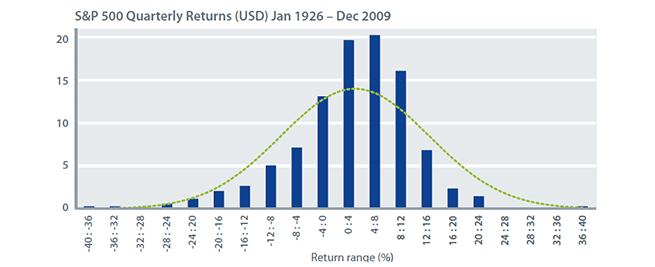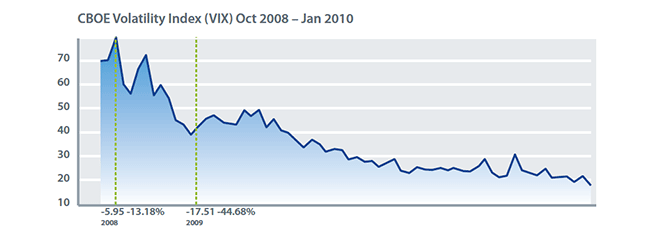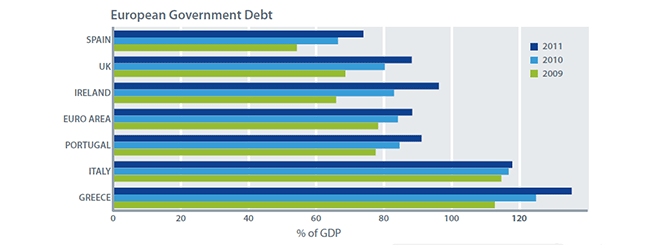Fat Tails From Black Swans
As we know, in statistics, certain data follows a normal distribution (sometimes referred to as a bell curve), and that most observations occur near the mean/average and very few occur far away from the mean/average in the ‘tails’.

The standard deviation tells us what percent of observations occur near the mean and the larger the standard deviation, the more frequent the observations occur away from the mean. In a normal distribution, 95% of the observations happen within 2 standard deviations (SD) of the mean and the probability of observations occurring outside of this range is very low. Certain data follows a normal distribution and others don’t. For example, height follows a normal distribution and there are very few observations far away from the mean in the ‘tails’. Financial markets prices do not follow a normal distribution and have many observations in both the far right and far left ends, thus exhibiting fat tails’. For example, if stock returns followed a normal distribution, then the probability of us experiencing market crashes (an event greater than 2 SD away from the mean) would be very low and would only occur once or twice in our lifetime (or once every 44 years). In reality, we experience stock and bond market crashes (and bubbles) far more frequently and have recently experienced 6 and 7 SD events which would only happen once every 3 billion years if market returns followed a normal distribution.
Benoît Mandelbrot wrote significant research on this topic and suggested that price changes in financial markets did not follow a normal distribution but rather a Lévy stable distribution making the problem of modeling risk much more difficult. In 1964, Eugene Fama(1) at the University of Chicago, under the supervision of Mandelbrot, wrote about fat tails in his PhD thesis and about how the movement of stock prices was unpredictable and followed a random walk. He went on to discuss how it was next to impossible to model fat tail risk and many models that are used today, such as Value-at-Risk, simply don’t work in extreme circumstances. As Nassim Taleb has been telling us for years, it’s impossible to predict the ramifications of Black Swans. Black Swan events such as September 11, countries like Russia (who never defaulted) defaulting on their debt, the first collapse of a major global investment bank (Lehman Brothers), etc. happen regularly and create 6 and 7 SD events. Looking at the past and trying to accurately model the future is next to impossible as no one can predict Black Swan events.
The best solution for such a problem is to diversify your investments amongst asset classes that provide some kind of value to your portfolio (return, low correlation, low risk, etc.) and then regularly rebalance your portfolio. 2008 and 2009 were good examples of years when fat tails occurred in the prices and volatility of many financial assets. After Lehman Brothers collapsed, the correlation of many asset classes spiked and the price of most risk assets fell significantly, quickly and in tandem until the first week of March 2009. At that point the price of many risk assets reversed and rose significantly and quickly in tandem until the summer when correlation amongst asset classes started to fall again. As an investor, a diversified portfolio provided you huge diversification benefits as treasuries and other government bonds appreciated while most risk assets fell. If you continued to invest in a diversified portfolio and rebalanced back to your strategic allocation in February, March or April, you were in effect selling government bonds near multi-year highs and buying risk assets near their multi-year lows. This is what we did for our discretionary accounts(2). After a substantial rise in risk asset prices off their March lows, we have recently been rebalancing portfolios back to their strategic allocation again to ensure a consistent mix between high risk and low risk assets in line with each client’s risk profile.

Summing Up The Year
Last year we saw an ongoing recovery in small, value, emerging, duration and credit premiums. International markets recovered more quickly than that of the United States and risk in equities and corporate fixed income decreased across markets. The VIX index (a measure of risk in equities) fell substantially from over 40 at the end of 2008 to under 20 at the end of 2009 as risk aversion abated. During the height of the financial crisis, the VIX index peaked at over 80. Risk aversion has also widely decreased except when it comes to many developed government bonds that have excess amount of debt and are now demanding higher yields to compensate for the risk. Also, as ever, diversification remains important as does a rebalancing strategy.

Concerns We Highlighted Last Year
Over the year we also highlighted our concerns about the risks in European government bonds of the PIIGS (Portugal, Ireland, Italy, Greece and Spain) and some Eastern European countries, the US economy in general and potential weakness of the USD and the extremely low yields in US Treasury Bonds. Some of these themes started to play out in 2009 and we think some will continue into 2010.
Piigs, The Euro & Euro Government Bonds
Fitch downgraded the Greek government’s credit rating in December for the second time this year to BBB+ with a negative outlook. A few days later, Greece’s prime minister spoke at an EU summit and admitted that his country’s public sector was rife with corruption. On the same day, S&P downgraded its outlook for both Spain and Portugal. Prior to the fourth quarter, Greece, Spain, Ireland and Portugal already experienced credit downgrades and the UK suffered from a negative long-term credit outlook. This comes as the Bank of England pumped another £25bn into the economy in the fourth quarter up to a total of £200bn last year.

In our previous Investment Quarterlies we have repeatedly warned about the excessive government debt burdens within Europe, the UK and the US and about the significant risk that yields would ultimately rise to reflect the greater risk associated with a government default. We saw government debt auction failures on multiple occasions and very recently debt auctions by the US government have been very weak, pushing yields up further. We have been experiencing rising yields on many government bonds from these countries all year and we believe yields can continue to rise further. We have been underweighting government debt in all of these countries which has paid off handsomely as many of these bonds lost value last year. This is in stark contrast to the rising value of government bonds in many less heavily indebted countries, an area we have been allocating to for some time.
USD & US Economy Weakness
The US Treasury Department extended the TARP (Troubled Asset Relief Program), which was due to expire in late 2009, to October 2010, as more than $118 billion of rescue money has been repaid by the banks. In 2009 US regulators closed 136 US Banks that failed and the number of FDIC-insured 'problem' institutions (552) leapt last year and reached a 16 year high. A year earlier there were only approximately 175 'problem' institutions and less than 100 a year before that. Last quarter, total loan balances by banks also contracted by 3%, the fastest decline in over 25 years. US unemployment surged to 10.2%. Since the recession began, more than 7.3 million people have lost their jobs in the US.
The fourth quarter, however, saw a large reversal for both US inflation and US unemployment. Inflation picked up and increased by about 2.7% year on year. 30-year mortgage rates in the US fell to a 30 year low of 4.71% in early December but have since risen in line with the long-term Treasury. November’s unemployment numbers also finally bucked the trend and fell for the first time in more than a year. Retail sales rose for the second month in a row in November raising hopes that a consumer recovery is on the way.
All in all, the US economy appears to have stopped deteriorating and now the question is whether we 'double dip', stay flat or return back to growth. We are still concerned about the massive amount of current and future government borrowing requirements and do not believe there is a simple or quick fix to the US economy’s woes.
Treasury Yields at Lifetime Lows
At the beginning of the year we highlighted this concern and felt that long-term US Treasury yields would ultimately move higher in the US. Yields did move substantially higher, Treasury auctions have been poorly received, the US government has borrowed record amounts and the dollar has fallen. During the same period, yields on the 3-month Treasury bond fell to zero (in November). We would not be surprised if the yields on long-term treasuries continued to move higher into 2010 as short-term rates remained relatively low for at least a couple more quarters.
The March to China Continues
Anthony Bolton, one of the most successful asset managers of all time, has announced he is coming out of retirement and moving to Hong Kong and setting up a fund to invest in Chinese equities. "The (investment) opportunity is simply too great to pass up. My retirement can wait a little while yet." Bolton joins the likes of Jim Rogers who moved to Singapore a few years ago and has full time Mandarin tutors for his children and Michael Geoghegan, HSBC's CEO who is moving to Hong Kong this month. In early 2009 China became the world’s largest car market surpassing the US for the first time ever. Towards the end of the year, the Chinese car market was still growing quickly as October car sales were up 77% year over year. In comparison, car sales in the US and most European countries were significantly lower during the same period.

Looking Forward
During a recent interview with Fortune magazine, Mohamed El-Erian, formerly the investment chief of Harvard University’s endowment fund and currently the CEO and co-CIO of PIMCO, was asked ‘What are the most important things that individual investors need to do differently?’ He responded by saying ‘The average investor has two issues today. First, the average investor is too U.S.-centric. There's a reason for that; the behavioural finance people will tell you that we like the familiar, so we tend to invest in names that we know, that give us comfort. The problem is that you don't want to be too U.S.-centric in a globalising world where the center of gravity is shifting. So the first thing for the average investor to recognise is that the asset allocation of tomorrow is much more global than the asset allocation of yesterday. Second, most of us have been very lucky -- we haven't had to worry about inflation for a long time. We're moving toward a much more fluid world in which, at some point, inflation will come back.’
MASECO has felt this way for some time and we have already adopted very global, less US centric strategic asset allocations and are being vigilant about what we feel is the inevitable reappearance of inflation in the developed world. We believe 2010 will be more challenging for investors as governments and central banks start to withdraw stimulus packages and we believe that regions will perform in less highly correlated manners than during the financial crisis of 2008/09.
We wish you and your families a healthy and happy 2010 and we look forward to helping your family with their financial and investment needs for 2010 and for years to come.
Best regards,
Josh Matthews |
James Sellon, CFA
|
- Eugene Fama is the director of research at Dimensional Fund Advisors (DFA).
- In our Q1 Investment Quarterly, we wrote: ’Massive outflows from mutual funds are usually a contrarian positive indicator for future equity returns as evidenced by multiple academic studies. Many other indicators such as the Short Interest Share or Margin Debt as a percentage of Market Cap are also bullish indicators at this time. Although we do not know the current or future direction of equities, most major equity markets are now yielding substantially more than their country’s government bonds. The last time we saw this in the US and UK was over 50 years ago and it also has not happened for decades in the rest of Europe. We expect the real economy to struggle in 2009 and we must ask ourselves whether this is already priced into the equity markets and if so, can you as an investor withstand the volatility that is almost certain to continue in 2009?
^ back to top
10 Charles II Street
London, SW1Y 4AA
United Kingdom
T +44 (0) 20 7043 0455
F +44 (0) 20 7043 0456
E enquiries@MASECOfinancial.com
